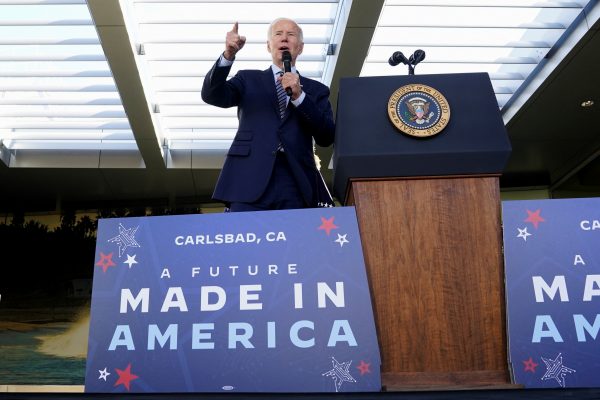With deep government pockets, a large domestic market and potent research and development capabilities, the United States has the economic power to capture a significant share of global investment in targeted industrial sectors. The US turn towards protectionism and its desire to shift trade to ‘like-minded’ friends raise fears that the US market will be closed to Asian exports unless US demands for common standards and supply chain configurations are met.
The CHIPS and Science Act, passed by the US Congress in 2022, illustrates Washington’s ‘reshoring’ intentions and their implications for trading partners. The act is designed to ‘bring back’ domestic semiconductor manufacturing that is presently concentrated in Asia by offering a menu of subsidies, tax credits and domestic content rules that promote onshore research, development and manufacturing. Bipartisan support for the funding comes from the centrality of semiconductors to civilian and military technology and concerns over the geopolitical vulnerability caused by fabrication that has moved to mainland China and Taiwan.
The CHIPS Act subsidises onshore investment in semiconductor fabrication, promising US$39 billion of manufacturing incentives on top of 25 per cent investment tax credits. These incentives seem to already be attracting the major semiconductor fabricators and their suppliers to invest in the United States.
According to the Semiconductor Industry Association, from the CHIPS Act’s introduction in 2020 to June 2023, 67 new projects and expansions of existing US facilities were announced in research and development, intellectual property, chip design, semiconductor fabrication and manufacturing equipment, supplies and materials. This new activity contrasts with the steady decline in the US share of global semiconductor manufacturing, which fell from 19 per cent in 2000 to only 12 per cent in 2020.
Assessing how many of these projects have been attracted to the United States because of CHIPS Act subsidies is difficult. The allocation of these funds has not occurred yet and some of these investments might have been made regardless. But US export controls on advanced chips and the equipment and supplies needed to produce them have undoubtedly affected decisions within the industry because they limit the materials that can be sent to China for manufacturing.
The CHIPS Act explicitly pulls investment from global semiconductor companies to the United States, raising fears that US industrial subsidies will hollow out tech industries in other regions. East and Southeast Asia is home to 10 of the 16 semiconductor exporters and the top six suppliers, accounting for 84 per cent of global exports in 2021.
While US subsidies are clearly a response to this regional concentration, expanding production capacity in the United States will affect the markets that these exporters now serve. On the one hand, US chip-related activities may reduce US chip imports from some Asian suppliers. But they may also expand trade in materials, equipment and more labour-intensive activities, such as testing and packaging.
How the industry and the market for Asian semiconductor-related exporters evolve in the future also depends on the actions of other countries. In response to the CHIPS Act, the European Union, Taiwan, Japan and South Korea have initiated or extended subsidy programs of their own.
In 2022 the EU launched the European Chips Act to ease government funding rules for semiconductor plants. In August 2023, the Taiwan Semiconductor Manufacturing Company announced plans to build a US$11 billion chip manufacturing plant in Germany, in a deal that reportedly includes up to US$5.5 billion in government subsidies. The United Kingdom also announced a 20-year strategy for its domestic semiconductor industry, recognising its inability to compete with massive US and EU subsidies and focusing on areas where it already has competencies.
This high level of intervention in the industry raises the spectre of a coming glut of semiconductors and falling world prices, even as the cost of production by new players is expected to exceed those in more established locations. If such a scenario plays out, governments will be tempted to protect subsidised manufacturers behind import tariffs or offer customer subsidies conditioned on domestic content requirements.
The US turn to such restrictions is evident in the Inflation Reduction Act, passed in August 2022, which provides subsidies to purchasers of electric vehicles assembled in the United States. The threat to Asian suppliers is clear if the subsidy race blocks semiconductor export markets and lowers world prices.
Another concern for Asian suppliers may arise from US demands to reduce Chinese involvement in supply chains. To date, Washington has not made such demands directly, but the CHIPS Act’s investment tax credits are contingent on recipients refraining from significant new investments in manufacturing facilities in China. This indicates that the United States intends to reduce links to the Chinese industry.
The implications of such ambitions are unclear. Silicon is produced by a handful of countries, but the largest supplier by far is China. Pressure to find alternative sources will be a problem throughout the industry. Even if the United States completely removes China from the supply chains that serve domestic chip manufacturers, it will still rely on imports of legacy chips from foreign partners.
Through ongoing consultations, facilitated in part by the Indo-Pacific Economic Framework’s new Supply Chain Council, Asian exporters may be able to moderate negative spillovers from the emerging semiconductor subsidy race and open up space for their participation in the expanding US industry. The Council, envisioned to meet at least annually, is tasked with exploring options to diversify concentrated supply sources for sectors and goods of shared interest. Member countries could work to avoid duplication, maintain open trade among members and gradually modify critical material sourcing.
Mary E Lovely is the Anthony M. Solomon Senior Fellow at the Peterson Institute for International Economics.
This article appears in the most recent edition of East Asia Forum Quarterly, ‘Industrial policy 2.0’, Vol 15, No 4.

